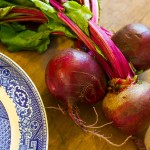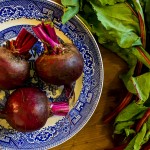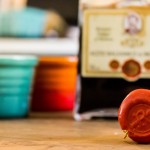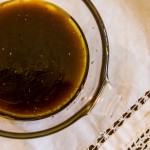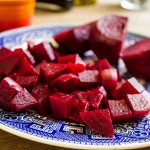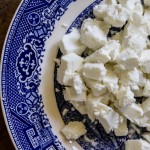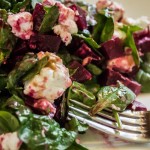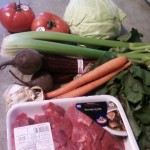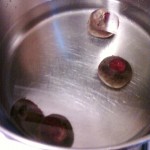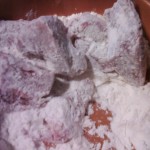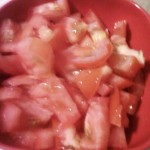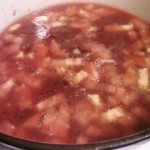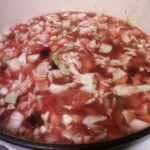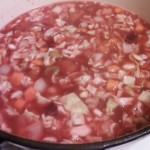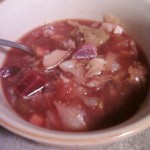 This Meatless Monday, we feature Beets, with growing, storage and prep tips, as well as recipes for Beet and Goat Cheese Salad and Borscht from Vermont Fresh: A Fruit and Vegetable Handbook.
This Meatless Monday, we feature Beets, with growing, storage and prep tips, as well as recipes for Beet and Goat Cheese Salad and Borscht from Vermont Fresh: A Fruit and Vegetable Handbook.
Background
Grown now for thousands of years, beets are a truly old-fashioned vegetable. The wild ancestor of the beet we eat today is native to the Mediterranean region, where it still grows today. The Greeks and Romans used beets primarily for their leaves, however, and it wasn’t until the Middle Ages that the red roots of the plant became popular. Like many vegetables, beets were selectively bred to become the crop we know today. While the majority of beets are strikingly red in color (particularly when cut), golden and candy-striped varieties are popular as well. The beets that we eat are closely related to sugar beets, which are grown in extensive quantities in America for the production of sugar. Recently, the pigment producing compounds in beets have been found to help fight against heart disease and cancer, particularly colon cancer.
Growing Tips
Beets are hardy roots that actually thrive in cooler weather. Seeds can be sown directly into the soil in early spring or started inside and transplanted later. If transplanting, take care not to disturb the roots. Either way, beets will probably need to be thinned as they begin to grow—each seed cluster can produce more than one plant, and the roots need room to develop. Beet greens can be harvested as the roots grow but several leaves do need to be left intact for the plant to continue growing steadily. Beets grow best in loose soils with plenty of water and nutrients. Compacted soil will make it harder for the plants to grow, resulting in tougher, smaller roots. For a steady supply of beets, try sowing seeds every 3 or 4 weeks until midsummer. Light frosts will not damage beets, but they should be harvested before regular heavy frosts set in.
Storage
For long-term storage, beets are often pickled and canned. For a more short-term approach, store in your refrigerator (with 2-3 inches of stem attached) for about 3 weeks. Cooked beets can be frozen, but raw beets freeze poorly. You can also try storing beets in a root cellar or cool (but not freezing) garage. Submerged in a bucket of sand, they will keep for months.
Nutritional Benefits
Beets are high in sugar, making them often very sweet, but that does not make them unhealthy. Beets are very rich in nutrients such as Vitamin C, magnesium, and potassium. Furthermore, they are packed with phytochemicals and antioxidents and are thoughts to contribute to a healthy heart.
Preparation
Beet juice can stain, so take care when preparing beets, which can be eaten raw, boiled, steamed, roasted, or pickled. If boiling, leave the skins on until the roots are fully cooked, when you can rub off the outer layer. It is otherwise advisable to peel beets, especially if they are older and have tougher skins. For information on preparing beet greens, see “Swiss Chard/Beet Greens.”
Meatless Monday Recipe: Beet and Goat Cheese Salad
- Photo courtesy of Kate Pace
- Photo courtesy of Kate Pace
- Photo courtesy of Kate Pace
- Photo courtesy of Kate Pace
- Photo courtesy of Kate Pace
- Photo courtesy of Kate Pace
- Photo courtesy of Kate Pace
- Photo courtesy of Kate Pace
Kate Pace, a volunteer baking, tasting and testing recipes out of the Vermont Fresh Handbook tried out this recipe. Her comments and adjustments are in italics within the recipe below. You can find her on Facebook.
Serves 4 as a full plate, 6 as a salad course
Prep = 10 minutes, Beets cook 30 minutes (small beets) to 45 minutes (med/large beets) and all other steps can be done while beets are cooking, Post-cooking Peel and Toss = 10
Total Time from Start to Finish: 45 minutes to 1 hour
Ingredients:
- 6 small beets or 3 medium beets, unpeeled
- 4 ounces (approximately) creamy goat cheese, such a chevre
- 3 cups raw spinach
For the Salad Dressing:
- 1 T balsamic vinegar
- 2 T extra virgin olive oil
- 1 T honey or maple syrup
- 1 tsp Dijon mustard (optional)
- Salt and Pepper to taste
Dijon and Honey makes a wonderful, smooth and sweet dressing with a tiny kick. Maple Syrup is stronger and matched with mustard according to personal taste
Instructions:
- Wash unpeeled beets under cool water. Bring pot of water to a boil. Cut leafy greens and inch or two from the top and drop into pot. Cook until fork tender.
- While the beets are cooking, wash spinach, spin and place in large salad bowl.
- Whisk the vinegar, olive oil, honey/syrup, Dijon, salt and pepper to make dressing.
- Once the cooked beets are cool enough to handle, rub the skins off underneath lukewarm running water. A small paring knife can be a great help. Trim off the stem end and cut the beets into small, bite-sized chunks.
- In the large salad bowl, mix the spinach, beets and goat cheese. Dress and serve.
The goat cheese softens very fast at room temperature so it can be helpful to keep it in the refrigerator until just prior to mixing. Cut it into small pieces and it tosses more evenly.
Meatless Monday Recipe: Traditional Borscht
- Photo courtesy of Janice Santiago
- Photo courtesy of Janice Santiago
- Photo courtesy of Janice Santiago
- Photo courtesy of Janice Santiago
- Photo courtesy of Janice Santiago
- Photo courtesy of Janice Santiago
- Photo courtesy of Janice Santiago
- Photo courtesy of Janice Santiago
- Photo courtesy of Janice Santiago
Janice Santiago, a volunteer baking, tasting and testing recipes out of the Vermont Fresh Handbook tried out this recipe. She added these points to the recipe:
- 2 quarts of water = 8 cups of water
- The dredging and browning of meat doesn’t take 30 minutes – so was really ready for step 3 long before the 30 minutes step 1 was supposed to take.
- The recipe does NOT tell you to cut the beets up and add them into the recipe with the other ingredients. I thought that was silly, but I did – and they were yummy, but again for beginners – with no direction they might not do that.
- I ended up adding 6 bouillon cubes to the beet water/broth for flavor. I think this is a must to add more flavor and to give the beet water/broth more body.
- I salt and peppered along the way – still feel like there should be some spice or herb that could be added to give it a little more of a punch. I wasn’t sure what it was….but it could have used something. Would also be good to season the flour when dredging.
- I didn’t serve with sour cream – as I don’t really like sour cream all that much. The Borscht was very good and really had so many veggies in it and amazing flavors from them. I wish I had cut the meat up into smaller pieces (to make more uniform with veggies), but then it would have impacted the cooking time.
- I will make this again, but using short cuts – like canned beats, possibly canned tomatoes if no fresh ones were on hand. I’d also try it with beef stock the next time for even more flavor and play with the herbs/spices.
Serves 6
(adapted from Rombauer et al: The Joy of Cooking)
Ingredients
- 3-4 medium-sized beets, unpeeled
- 1 lb stew beef
- ¼ cup all-purpose flour
- 2 tablespoons vegetable or olive oil
- 2 large tomatoes, diced
- Beef bouillon or stock (optional)
- ¼ – ½ head cabbage, chopped
- 2 carrots, diced
- 1 onion, coarsely chopped
- 2 stalks of celery, chopped
- 1 tablespoon vinegar
- 2 cloves garlic, chopped (or 2 teaspoons powdered)
- Salt and pepper
- Sour cream (optional)
Instructions
- Bring 2 quarts of water to a boil and cook beets until tender, about 30 minutes.
- While beets are cooking, dredge beef in flour. In heavy-bottomed soup pot, heat oil, then add meat and cooked until browned.
- Remove beets from water (do not discard!), and if desired, rub off the skins under running water.
- Pour beet water into soup pot with beef, add tomatoes, and simmer over low heat until beef is tender, about 30 minutes. Add bouillon or stock if desired.
- Add cabbage, carrots, onion, celery, vinegar, and garlic. Simmer until vegetables are tender, adding more water or stock if necessary.
- Add salt and pepper to taste and serve hot with sour cream.
To receive more recipes and tips on your favorite fruits and vegetables, download Vermont Fresh: A Fruit and Vegetable Handbook. Vermont Foodbank fresh food initiatives would not be possible without your support. Please consider giving to the Vermont Foodbank today!

